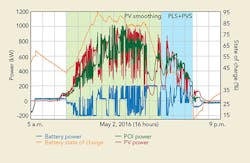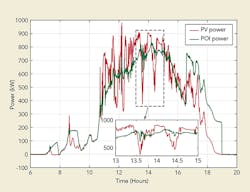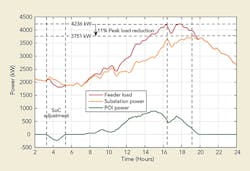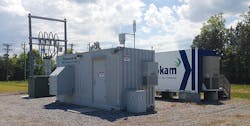Integrating Solar and Storage with the Grid
The grid is facing new challenges. The proliferation of renewable energy generation on transmission and distribution networks is not only gradually exacerbating previously wieldy grid complications but also creating new ones. In the past, utility distribution assets like voltage regulators had to address only slow-changing voltage fluctuations resulting from the natural change in consumer load, be it residential or industrial. Now these traditional devices are tasked with addressing a new spectrum of grid dynamics caused by intermittent distributed renewable generation.
For instance, voltage regulators are now reacting to at least two new dynamics, namely, voltage swells exhibited during peak distributed generation hours, and voltage spikes or transients caused by the intermittent nature of renewables’ power profiles. Similarly, conventional peak generation units are increasingly being subjected now to far more severe ramp rates, caused mainly by the coincidence in times of decrement of renewable power (solar power ramp-down) and increment of load (load ramp-up) — also known as duck curves. Further, grid operators are anticipating and even experiencing reverse power flow at distribution substations that can significantly impact the utility’s protection schemes because protection relays installed may not have directional capability.
Energy storage systems (ESSs) can accommodate a wide variety of applications, making them a viable solution to enhance grid resilience and enable further penetration of renewables on the grid. However, the current capital cost and cycle life of storage technologies, although improving, are still at a point where only stacked applications operation makes economic sense. The key is manipulation of the active and reactive power capabilities of ESSs to achieve multiple value streams and maximize total benefit while maintaining operational efficiency such that battery life is not being compromised.
Duke Energy and the Energy Production and Infrastructure Center (EPIC) at the University of North Carolina at Charlotte realized this need in early 2013 and embarked on a joint research venture using Duke Energy’s Marshall photovoltaic/energy storage system (PV/ESS) site as the test bed. The design of the multi-value stream controller was made possible by using Duke-funded state-of-the-art laboratories at EPIC.
Battery Energy Storage System
The battery energy storage system (BESS) test bed at Marshall consists of a 250-kW, three-hour lithium-polymer battery system from Kokam, operated by a 1.25-MVA inverter from S&C Electric Co. The BESS sizing and topology enables charge and discharge operations of the BESS regardless of the reactive power dispatch state. This provides great flexibility in terms of multiple application operation. The BESS is connected in conjunction with a 1-MW PV facility at the same point of interconnect (POI). Both systems are interconnected to the grid through a 12.47-kV radial distribution feeder. This 720-node feeder has three static capacitor banks, two line voltage regulators and a single substation voltage regulator.
The ESS Stacked Application Controller (ESAC) methodology relies on data gathered from different points of the distribution feeder. These data sets are published through Duke’s open field message bus (OFMB), where data can be accessed by different devices. The controller subscribes to the message bus and acquires real-time data inputs needed for running the BESS stacked applications. Real-time system data is used for real-time controller calculations and also recorded to maintain a certain period of historical system data.
Both real-time system data and recorded historical data are used within the controller to enhance learning and update system models through an adaptive control methodology. Three primary applications operate simultaneously through ESAC. These applications are PV smoothing (PVS), peak load shaving (PLS) and voltage support. While the first two applications share the active power capacity of the BESS, the third application uses the reactive power capabilities of the battery inverter.
Photovoltaic Smoothing
The first application ¾ PVS ¾ aims to minimize unavoidable PV power swings caused by cloud passing. Counteracting such swings is of the utmost importance to minimize transients caused by renewable distributed energy resources on distribution feeders. The BESS PVS algorithm targets high ramp-rate power swings occurring throughout the PV plant’s time of operation. These power swings are detrimental to utility assets, such as voltage regulators, and compromise feeder power quality through stimulating voltage spikes and frequency transients. The PVS algorithm uses a target power reference to satisfy optimal POI power output during a PV power swing. This reference is deduced by taking into account the PV swing severity (ramp rate), BESS lifetime and state of charge (SoC).
The PVS algorithm consists of four main stages.
• A characteristic PV curve is learned by the controller from the daily output curves of the PV facility. The way this curve is deduced makes it specific to the PV facility location, size, technology (tracking or fixed tilt), degradation and season (length of day). It also renders the ESAC controller compatible with any PV system without reprogramming.
• A POI reference power curve is deduced and optimized in real time to minimize POI power swings (perceived by the grid), maximize BESS cycle life and maintain SoC at desired values to enable the multi-application capability for the BESS.
• A power intermittency detection algorithm triggers the BESS to commence and halt smoothing based on both forecasted and real-time PV station ramp rates.
• The deduced power reference is compared with the instantaneous PV power output to deduce the required BESS power dispatch level, to alleviate existing power swings and satisfy deduced optimal power at the POI.
Peak Load Shaving
The second storage application — peak load shaving (PLS), integrated into ESAC and sharing active power with the PVS application — aims to achieve the electricity market equivalent of financial arbitrage. The financial definition of arbitrage is the simultaneous purchase and sale of identical commodities across two or more markets to benefit from a discrepancy in their price relationship. To efficiently achieve this in the electrical sector, the precise prediction of peak load magnitude and time is crucial.
Studying historical load curves for various residential distribution feeders, it was found that applying a weather forecast-based neural network prediction methodology provides accurate prediction. The algorithm constantly monitors the battery SoC and deduces the optimal time of day to commence battery discharge such that the predicted load curve maximum time lies in the middle of the discharge period.
Further, the smoothing power reference in the first ESAC application is made a function of PLS time such that both applications are optimally executed. Simultaneously, when PV swings occur during the PLS discharge time of the ESS, the ESAC controller functions such that these swings are addressed with only the discharge half of the active power capabilities of the ESS. This enables ESAC to realize values of both applications simultaneously.
Voltage Support
For the third application — voltage support — the goal is to calculate the reactive power to be injected at the POI to minimize voltage regulator tap operations throughout distribution feeders and, at the same time, firm voltage at the POI to mitigate voltage spikes caused by the distributed renewable energy resource connected at the same bus. Therefore, the algorithm consists of two main functions operating at two different frequencies:
•The first function addresses voltage regulator dynamics using real-time measurements of primary and secondary voltages at all three voltage regulators.
• The second function addresses the higher frequency voltage dynamics at the POI.
For implementation, voltages at the substation, the POI and all three voltage regulators are constantly monitored. Accordingly, the optimal instantaneous reactive power set point is calculated in real time within the controller and executed by the BESS. During operation, the number of unexecuted tap operations is deduced using tap operation warning sensors from the feeder voltage regulators. This provides a real-time analytical metric for the efficiency performance of the voltage support application and supports value prioritization needs within the controller.
Duke Energy's Experience
The described applications have been running simultaneously for more than a year at Duke Energy’s Marshall facility. Various value streams have been realized including tap operation reduction of voltage regulators to less than 30% of previous values. Noon power swings are being reduced by 70% while maintaining ESS SoC within optimal levels to accommodate PLS and maintain the lifetime of the battery. PLS is reducing voltage sags caused by feeder peak loads successfully and also reducing the need for peak generation units.
As solution providers develop more advanced devices capable of efficiently integrating energy storage units with renewables, BESS controllers such as the one developed here come into play. For instance, several commercial dual-port solar/storage inverters are fully capable of integrating such ESAC controllers. These solutions especially become appealing as higher solar direct-current/ac-current ratios continue to make more economic sense and clipped noon energies continue to increase.
Solar developers are now setting their sights on clipped energy and investigating how to harvest it on the DC side for later dispatch. However, with the current cost of energy storage units, a single clipped energy harvest storage application will not be economically viable. Therefore, integrating stacked application controllers could be the solution. Further, utility initiatives aiming to replace peak combustion turbine generation units with energy storage could benefit greatly from an improved business case provided by the ESAC methodology.
A Positive Business Case
Even at the current cost of ESS, stacked application systems can still provide a positive business case that enables the use of the technology for further penetration of renewables on the grid. This satisfies the need and necessity of a cleaner, greener and more sustainable grid future that aligns with the goals of Duke Energy’s Road Ahead framework.
Acknowledgments
The authors gratefully acknowledge Dr. Sukumar Kamalasadan’s role in managing the research effort. The authors also would like to extend their most sincere appreciation to Duke Energy’s emerging technology group represented by Tom Fenimore, Jonathon Rhyne and Michael Rowand for their support throughout the project phases.
Sherif A. Abdelrazek is in Duke Energy’s distributed energy resources group supporting utility-scale photovoltaics, microgrid, energy storage and combined heat and power. He received a bachelor’s degree in electrical power and machines engineering from Ain Shams University, Cairo, Egypt, and a MSEE degree and Ph.D. in electrical engineering from the University of North Carolina at Charlotte.
Johan H. Enslin is the director for the Energy Production and Infrastructure Center and the Duke Energy distinguished chaired professor in power system at the University of North Carolina at Charlotte. Enslin has combined a 34-year career with leadership in industry and academia, and served as an executive for private business operations and a professor in electrical engineering. Enslin has worked for more than 80 power utilities, governments and industries worldwide.






